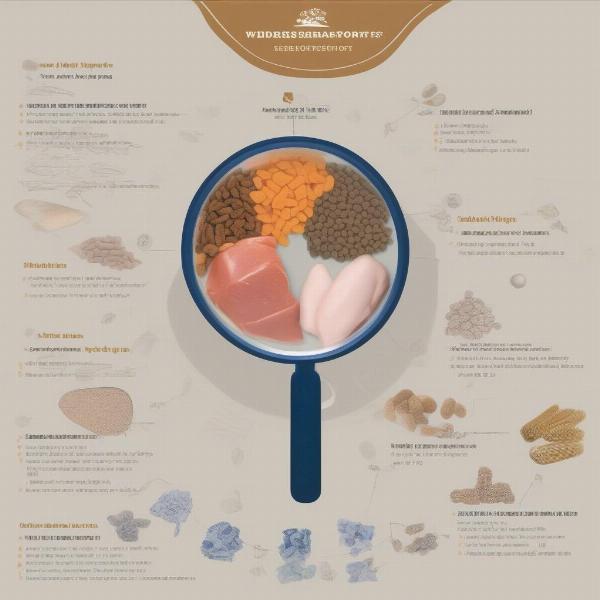Blue Wilderness dog food often attracts pet owners with its marketing emphasizing a “high-protein, grain-free” formula inspired by the diet of wolves. But what exactly are blue wilderness dog food ingredients? Understanding the ingredient list is crucial for choosing the best nutrition for your canine companion. This article will break down the components of Blue Wilderness, helping you make an informed decision.
Decoding the Ingredient List of Blue Wilderness Dog Food
Blue Wilderness offers various formulas for different life stages and sizes. While the specific ingredients may vary slightly, they generally share a similar foundation. Let’s dissect the core components:
-
Protein Sources: Blue Wilderness typically features deboned chicken, chicken meal, fish meal (salmon, menhaden, whitefish), or red meat (beef, bison) as primary protein sources. These provide essential amino acids for muscle development and overall health.
-
Fats and Oils: Chicken fat, fish oil, and flaxseed are common sources of healthy fats. These contribute to energy, skin and coat health, and cognitive function.
-
Fruits and Vegetables: Blue Wilderness incorporates a blend of fruits and vegetables like blueberries, cranberries, carrots, and sweet potatoes. These provide vitamins, minerals, and antioxidants.
-
Other Ingredients: The ingredient list also includes pea protein, pea fiber, dried chicory root, and other ingredients that provide fiber, prebiotics, and other nutrients.
 Blue Wilderness Dog Food Ingredient Analysis
Blue Wilderness Dog Food Ingredient Analysis
Is Blue Wilderness a Good Choice for Your Dog?
Blue Wilderness has garnered both praise and criticism. Many appreciate its high protein content and grain-free formulation, particularly for dogs with grain sensitivities. However, some concerns have been raised about potential links to dilated cardiomyopathy (DCM) in some dogs, though research is still ongoing.
What to Look for in Dog Food Ingredients
When evaluating any dog food, consider the following:
- Named Protein Sources: Look for specific meat sources like “chicken” or “beef,” rather than generic terms like “meat by-products.”
- Limited Fillers: Avoid excessive amounts of fillers like corn, wheat, and soy, which offer little nutritional value.
- Balanced Nutrients: Ensure the food provides a complete and balanced profile of vitamins, minerals, and other essential nutrients.
Common Questions about Blue Wilderness Dog Food Ingredients
What are the benefits of a high-protein diet for dogs? A high-protein diet supports muscle growth, repair, and overall energy levels.
Are there any risks associated with grain-free dog food? Some studies have suggested a potential link between grain-free diets and DCM in certain dogs, although more research is needed.
What are some alternatives to Blue Wilderness? Other high-protein, grain-free options include brands like Orijen, Taste of the Wild, and Instinct. Always consult your veterinarian before switching your dog’s food.
blue buffalo wilderness dog food reviews
Addressing Specific Dietary Needs with Blue Wilderness
Blue Wilderness also offers specialized formulas for puppies, seniors, and dogs with specific dietary requirements. Always choose a formula that aligns with your dog’s age, breed, activity level, and any health conditions.
Blue Wilderness for Puppies
Puppies need a higher calorie and nutrient density to support their rapid growth. Blue Wilderness puppy formulas are designed to meet these needs with increased protein and fat levels.
Blue Wilderness for Senior Dogs
Senior dogs often require lower calorie intake and increased support for joint health. Senior formulas typically have reduced fat and added ingredients like glucosamine and chondroitin.
reviews of blue buffalo wilderness dog food
Conclusion
Understanding blue wilderness dog food ingredients is essential for responsible pet ownership. While the brand offers high-protein, grain-free options appealing to many, it’s crucial to consider your dog’s individual needs and consult your veterinarian for personalized dietary advice. Carefully examining the ingredient list and staying informed about ongoing research will empower you to make the best nutritional choices for your furry friend.
FAQ
- Is Blue Wilderness suitable for all dog breeds? While generally suitable for many breeds, individual needs vary. Consult your veterinarian.
- What are the signs of a dog food allergy? Symptoms include itching, skin irritation, digestive issues, and ear infections.
- How often should I change my dog’s food? Avoid frequent changes unless necessary. Gradual transitions are recommended.
- Can I mix Blue Wilderness with other dog foods? Mixing is generally discouraged as it can disrupt nutritional balance.
- Where can I purchase Blue Wilderness dog food? It’s available at most pet stores and online retailers.
- Does Blue Wilderness offer wet food options? Yes, they have wet food formulas as well as dry kibble.
- Is Blue Wilderness a good value for the price? It’s a mid-range to premium brand, offering decent quality for the cost.
ILM Dog is a leading international website dedicated to providing expert advice and resources for dog owners worldwide. We offer comprehensive information on dog breeds, health, training, nutrition, grooming, and much more. Whether you’re a new puppy parent or a seasoned dog owner, ILM Dog is here to support you every step of the way. Contact us at [email protected] or +44 20-3965-8624 for personalized guidance on dog nutrition and care. Explore our extensive library of articles and resources to learn more about caring for your canine companion. Visit ILM Dog today!